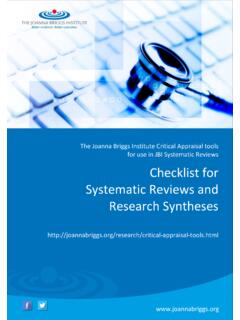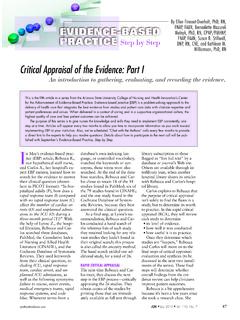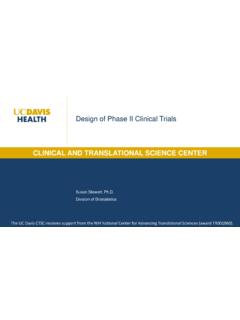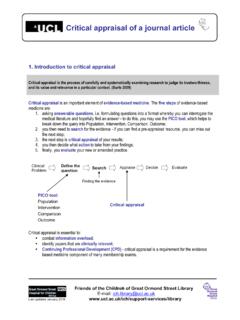Transcription of for use in JBI Systematic Reviews Checklist for Randomized ...
1 The Joanna Briggs Institute Critical Appraisal tools for use in JBI Systematic Reviews Checklist for Randomized controlled Trials Joanna Briggs Institute 2017 Critical Appraisal Checklist for Randomized controlled Trials 2 The Joanna Briggs Institute Introduction The Joanna Briggs Institute (JBI) is an international, membership based research and development organization within the Faculty of Health Sciences at the University of Adelaide. The Institute specializes in promoting and supporting evidence-based healthcare by providing access to resources for professionals in nursing, midwifery, medicine, and allied health.
2 With over 80 collaborating centres and entities, servicing over 90 countries, the Institute is a recognized global leader in evidence-based healthcare. JBI Systematic Reviews The core of evidence synthesis is the Systematic review of literature of a particular intervention, condition or issue. The Systematic review is essentially an analysis of the available literature (that is, evidence) and a judgment of the effectiveness or otherwise of a practice, involving a series of complex steps. The JBI takes a particular view on what counts as evidence and the methods utilized to synthesize those different types of evidence.
3 In line with this broader view of evidence, the Institute has developed theories, methodologies and rigorous processes for the critical appraisal and synthesis of these diverse forms of evidence in order to aid in clinical decision-making in health care. There now exists JBI guidance for conducting Reviews of effectiveness research, qualitative research, prevalence/incidence, etiology/risk, economic evaluations, text/opinion, diagnostic test accuracy, mixed-methods, umbrella Reviews and scoping Reviews .
4 Further information regarding JBI Systematic Reviews can be found in the JBI Reviewer s Manual on our website. JBI Critical Appraisal Tools All Systematic Reviews incorporate a process of critique or appraisal of the research evidence. The purpose of this appraisal is to assess the methodological quality of a study and to determine the extent to which a study has addressed the possibility of bias in its design, conduct and analysis. All papers selected for inclusion in the Systematic review (that is those that meet the inclusion criteria described in the protocol) need to be subjected to rigorous appraisal by two critical appraisers.
5 The results of this appraisal can then be used to inform synthesis and interpretation of the results of the study. JBI Critical appraisal tools have been developed by the JBI and collaborators and approved by the JBI Scientific Committee following extensive peer review. Although designed for use in Systematic Reviews , JBI critical appraisal tools can also be used when creating Critically Appraised Topics (CAT), in journal clubs and as an educational tool. Joanna Briggs Institute 2017 Critical Appraisal Checklist for Randomized controlled Trials 3 JBI Critical Appraisal Checklist for Randomized controlled Trials Reviewer Date Author Year Record Number Yes No Unclear NA 1.
6 Was true randomization used for assignment of participants to treatment groups? 2. Was allocation to treatment groups concealed? 3. Were treatment groups similar at the baseline? 4. Were participants blind to treatment assignment? 5. Were those delivering treatment blind to treatment assignment? 6. Were outcomes assessors blind to treatment assignment? 7. Were treatment groups treated identically other than the intervention of interest? 8. Was follow up complete and if not, were differences between groups in terms of their follow up adequately described and analyzed?
7 9. Were participants analyzed in the groups to which they were Randomized ? 10. Were outcomes measured in the same way for treatment groups? 11. Were outcomes measured in a reliable way? 12. Was appropriate statistical analysis used? 13. Was the trial design appropriate, and any deviations from the standard RCT design (individual randomization, parallel groups) accounted for in the conduct and analysis of the trial? Overall appraisal: Include Exclude Seek further info Comments (Including reason for exclusion) Joanna Briggs Institute 2017 Critical Appraisal Checklist for Randomized controlled Trials 4 Explanation for the critical appraisal tool for RCTs with individual participants in parallel groups How to cite: Tufanaru C, Munn Z, Aromataris E, Campbell J, Hopp L.
8 Chapter 3: Systematic Reviews of effectiveness. In: Aromataris E, Munn Z (Editors). Joanna Briggs Institute Reviewer's Manual. The Joanna Briggs Institute, 2017. Available from Critical Appraisal Tool for RCTs (individual participants in parallel groups) Answers: Yes, No, Unclear or Not Applicable 1. Was true randomization used for assignment of participants to treatment groups? The differences between participants included in compared groups constitutes a threat to the internal validity of a study exploring causal relationships.
9 If participants are not allocated to treatment and control groups by random assignment there is a risk that the allocation is influenced by the known characteristics of the participants and these differences between the groups may distort the comparability of the groups. A true random assignment of participants to the groups means that a procedure is used that allocates the participants to groups purely based on chance, not influenced by the known characteristics of the participants. Check the details about the randomization procedure used for allocation of the participants to study groups.
10 Was a true chance (random) procedure used? For example, was a list of random numbers used? Was a computer-generated list of random numbers used? 2. Was allocation to groups concealed? If those allocating participants to the compared groups are aware of which group is next in the allocation process, that is, treatment or control, there is a risk that they may deliberately and purposefully intervene in the allocation of patients by preferentially allocating patients to the treatment group or to the control group and therefore this may distort the implementation of allocation process indicated by the randomization and therefore the results of the study may be distorted.














